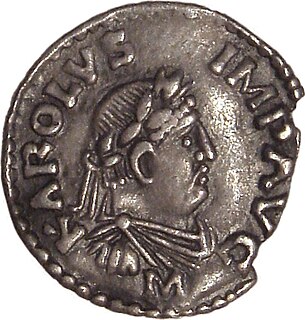
The Holy Roman Emperor, officially the Emperor of the Romans, and also the German-Roman Emperor, was the ruler of the Holy Roman Empire. The Empire was considered by the Roman Catholic Church to be the only legal successor of the Roman Empire during the Middle Ages and the early modern period. The title was held in conjunction with the title of King of Italy from the 8th to the 16th century, and, almost without interruption, with the title of King of Germany throughout the 12th to 18th centuries.
In ancient Rome, Imperium was a form of authority held by a citizen to control a military or governmental entity. It is distinct from auctoritas and potestas, different and generally inferior types of power in the Roman Republic and Empire. One's imperium could be over a specific military unit, or it could be over a province or territory. Individuals given such power were referred to as curule magistrates or promagistrates. These included the curule aedile, the praetor, the consul, the magister equitum, and the dictator. In a general sense, imperium was the scope of someone's power, and could include anything, such as public office, commerce, political influence, or wealth.

The Roman Emperor was the ruler of the Roman Empire during the imperial period. The emperors used a variety of different titles throughout history. Often when a given Roman is described as becoming "emperor" in English, it reflects his taking of the title Augustus or Caesar. Another title often used was imperator, originally a military honorific. Early Emperors also used the title Princeps Civitatis. Emperors frequently amassed republican titles, notably princeps senatus, consul and pontifex maximus.

The Latin word imperator derives from the stem of the verb imperare, meaning 'to order, to command'. It was originally employed as a title roughly equivalent to commander under the Roman Republic. Later it became a part of the titulature of the Roman Emperors as part of their cognomen. The English word emperor derives from imperator via Old French: Empereür. The Roman emperors themselves generally based their authority on multiple titles and positions, rather than preferring any single title. Nevertheless, imperator was used relatively consistently as an element of a Roman ruler's title throughout the principate and the dominate. In Latin, the feminine form of imperator is imperatrix.

The green peafowl is a species of peafowl found in the tropical forests of Southeast Asia. It is also known as the Java peafowl, but this term is properly used to describe the nominate subspecies endemic to the island of Java in Indonesia. It is the closest relative of the Indian peafowl or blue peafowl, which is mostly found on the Indian subcontinent.

The emperor scorpion, Pandinus imperator, is a species of scorpion native to rainforests and savannas in West Africa. It is one of the largest scorpions in the world and lives for 6–8 years. Its body is black, but like other scorpions it glows pastel green or blue under ultraviolet light. It is a popular species in the pet trade, and is protected by CITES.
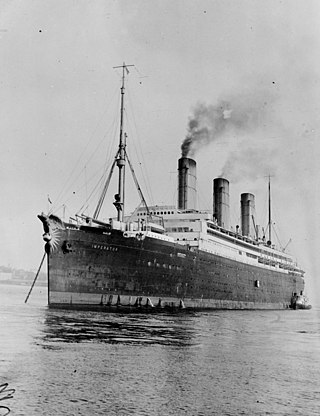
SS Imperator was a German ocean liner built for the Hamburg America Line, launched in 1912. At the time of her completion in June 1913, she was the largest passenger ship in the world by gross tonnage, surpassing the new White Star giants, Olympic and Titanic.
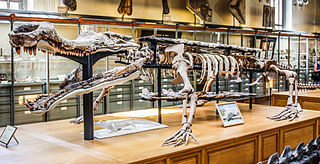
Sarcosuchus is an extinct genus of crocodyliform and distant relative of living crocodylians that lived during the Early Cretaceous, from the late Hauterivian to the early Albian, 133-112 million years ago of what is now Africa and South America. It was one of the largest crocodile-line reptiles, reaching an average estimate of 9 meters and 3.5 tonnes but estimated to grow up to 9.5 m in body length and weigh up to 4.3 tonnes. It is known from two species, S. imperator from the early Albian Elrhaz Formation of Niger and S. hartti from the Late Hauterivian of north-east Brazil, other material is known from Morocco and Tunisia and possibly Libya and Mali.

The emperor tamarin is a species of tamarin allegedly named for its resemblance to the German emperor Wilhelm II. It lives in the southwest Amazon Basin, in east Peru, north Bolivia and in the west Brazilian states of Acre and Amazonas.

The Hamburg-Amerikanische Packetfahrt-Aktien-Gesellschaft (HAPAG), often referred to as Hamburg America Line, was a transatlantic shipping enterprise established in Hamburg, in 1847. Among those involved in its development were prominent citizens such as Albert Ballin, Adolph Godeffroy, Ferdinand Laeisz, Carl Woermann, August Bolten, and others, and its main financial backers were Berenberg Bank and H. J. Merck & Co. It soon developed into the largest German, and at times the world's largest, shipping company, serving the market created by German immigration to the United States and later immigration from Eastern Europe. On 1 September 1970, after 123 years of independent existence, HAPAG merged with the Bremen-based North German Lloyd to form Hapag-Lloyd AG.

Tapejara is a genus of Brazilian pterosaur from the Cretaceous Period. Tapejara crests consisted of a semicircular crest over the snout, and a bony prong which extended back behind the head.

The Imperator Aleksandr II-class battleships were two battleships built for the Imperial Russian Navy in the 1880s. They were intended to counter the small armored ships of the other Baltic powers. Construction was very prolonged and the ships were virtually obsolescent when completed. They were optimized for ramming.

Spider-Man and the Fantastic Four is a four-issue comic book limited series published by Marvel Comics. It was published in May - August 2007, written by Jeff Parker and illustrated by Mike Wieringo shortly before his death.

Tupandactylus is a genus of tapejarid pterodactyloid pterosaur from the Early Cretaceous Crato Formation of Brazil. It is notable for its large cranial crest, composed partly of bone and partly of soft tissue. The genus Tupandactylus possibly contains two species, both bearing differently sized/shaped crests that may have been used to signal and display for other Tupandactylus, much as toucans use their bright bills to signal to one another. Tupandactylus crests consisted of a semicircular crest over the snout, and in the case of the type species T. imperator, a bony prong which extended back behind the head. A second species, T. navigans, lacked this prong, and had a much more vertical crest. Soft tissue impressions also show that the small bony crests were extended by a much larger structure made of a keratinous material. The complete crest of T. navigans rose in a sharp, sail-like "dome" high above the rest of the skull.

Augustus was an ancient Roman title given as both name and title to Gaius Octavius, Rome's first Emperor. On his death, it became an official title of his successor, and was so used by Roman emperors thereafter. The feminine form Augusta was used for Roman empresses and other females of the Imperial family. The masculine and feminine forms originated in the time of the Roman Republic, in connection with things considered divine or sacred in traditional Roman religion. Their use as titles for major and minor Roman deities of the Empire associated the Imperial system and Imperial family with traditional Roman virtues and the divine will, and may be considered a feature of the Roman Imperial cult.
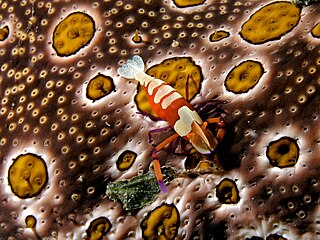
Periclimenes imperator, known as the emperor shrimp, is a species of shrimp with a wide distribution across the Indo-Pacific. It lives commensally on a number of hosts, including the sea slug Hexabranchus. A. J. Bruce first described it in 1967 based on eight specimens ranging from 4 millimetres (0.16 in) to 7.6 millimetres (0.30 in), and found Periclimenes rex to be its best resemblance.

The boa constrictor, also called the red-tailed boa or the common boa, is a species of large, non-venomous, heavy-bodied snake that is frequently kept and bred in captivity. The boa constrictor is a member of the family Boidae, found in tropical North, Central, and South America, as well as some islands in the Caribbean. A staple of private collections and public displays, its color pattern is highly variable yet distinctive. Nine subspecies are currently recognized, although some of these are controversial. This article focuses on the species Boa constrictor as a whole, and on the nominate subspecies B. c. constrictor.

The Colonial Auxiliary Forces Officers' Decoration, post-nominal letters VD, was established in 1899 as recognition for long and meritorious service as a part-time commissioned officer in any of the organized military forces of the British Colonies, Dependencies and Protectorates. It superseded the Volunteer Officers' Decoration for India and the Colonies in all these territories, but not in the Indian Empire.
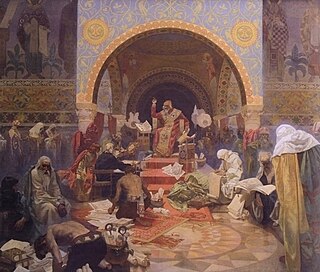
Tsar, also spelled czar, or tzar or csar, is a title used to designate East and South Slavic monarchs or supreme rulers of Eastern Europe, originally the Bulgarian monarchs from 10th century onwards, much later a title for two rulers of the Serbian State, and from 1547 the supreme ruler of the Tsardom of Russia and the Russian Empire. In this last capacity it lends its name to a system of government, tsarist autocracy or tsarism. The term is derived from the Latin word caesar, which was intended to mean "emperor" in the European medieval sense of the term—a ruler with the same rank as a Roman emperor, holding it by the approval of another emperor or a supreme ecclesiastical official —but was usually considered by western Europeans to be equivalent to king, or to be somewhat in between a royal and imperial rank.

Imperator: Rome is a grand strategy wargame developed and published by Paradox Interactive, which was released on 25 April 2019. It is a successor to Europa Universalis: Rome, released by Paradox in 2008. It received generally positive reviews from critics.



















